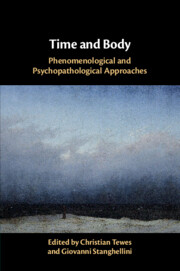Book contents
- Time and Body
- Endorsements for Time and Body
- Time and Body
- Copyright page
- Dedication
- Additional material
- Contents
- Figures
- Contributors
- 1 Introduction – Time and Body
- 2 Time, the Body, and the Other in Phenomenology and Psychopathology
- Part I Body and Time: General Aspects
- Part II Grief and Anxiety
- Part III Borderline Personality and Eating Disorders
- Part IV Depression, Schizophrenia, and Dementia
- 13 Intrinsic Temporality in Depression
- 13.1 Commentary on “Intrinsic Temporality in Depression: Classical Phenomenological Psychiatry, Affectivity, and Narrative”
- 14 Lost in the Socially Extended Mind
- 14.1 Commentary on “Lost in the Socially Extended Mind: Genuine Intersubjectivity and Disturbed Self-Other Demarcation in Schizophrenia”
- 15 Closing Up
- 15.1 Commentary on “Closing Up: The Phenomenology of Catatonia”
- 16 Embodied Selfhood and Personal Identity in Dementia
- 16.1 Commentary on “Embodied Selfhood and Personal Identity in Dementia”
- Index
- References
15 - Closing Up
The Phenomenology of Catatonia
from Part IV - Depression, Schizophrenia, and Dementia
Published online by Cambridge University Press: 30 October 2020
- Time and Body
- Endorsements for Time and Body
- Time and Body
- Copyright page
- Dedication
- Additional material
- Contents
- Figures
- Contributors
- 1 Introduction – Time and Body
- 2 Time, the Body, and the Other in Phenomenology and Psychopathology
- Part I Body and Time: General Aspects
- Part II Grief and Anxiety
- Part III Borderline Personality and Eating Disorders
- Part IV Depression, Schizophrenia, and Dementia
- 13 Intrinsic Temporality in Depression
- 13.1 Commentary on “Intrinsic Temporality in Depression: Classical Phenomenological Psychiatry, Affectivity, and Narrative”
- 14 Lost in the Socially Extended Mind
- 14.1 Commentary on “Lost in the Socially Extended Mind: Genuine Intersubjectivity and Disturbed Self-Other Demarcation in Schizophrenia”
- 15 Closing Up
- 15.1 Commentary on “Closing Up: The Phenomenology of Catatonia”
- 16 Embodied Selfhood and Personal Identity in Dementia
- 16.1 Commentary on “Embodied Selfhood and Personal Identity in Dementia”
- Index
- References
Summary
Catatonia is a severe psychiatric syndrome, characterized by specific motor abnormalities such as immobility, mutism, staring, rigidity, or psychomotor agitation. Until recently, it was often thought of as a subtype of schizophrenia. Today it is recognized to occur with different medical and psychiatric illnesses, and possibly independently thereof. Catatonia has a remarkable high incidence in the clinical setting, and its clinical presentation is often impressive and thought-provoking. Despite decades of scientific inquiry, catatonia remains poorly understood. Surprisingly, phenomenological psychopathology has only devoted little attention to the phenomenon. In order to increase our understanding of catatonia, this article investigates its phenomenology, i.e., its subjective and intersubjective presentation. We present a clinical vignette and clarify its phenomenology with emphasis on fear, embodiment, and temporality. Indirectly, this investigation will shed a different light on how trauma can affect subjectivity, in both its embodied and temporal dimension.
Keywords
- Type
- Chapter
- Information
- Time and BodyPhenomenological and Psychopathological Approaches, pp. 346 - 362Publisher: Cambridge University PressPrint publication year: 2020



